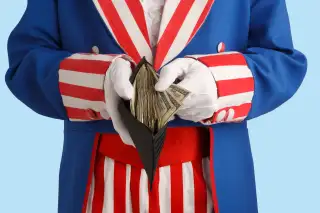Why I Dumped My Tax-Free Money-Market Fund—and You Should, Too!

I love tax-exempt income. It’s nice to be able to keep your interest and dividends from assets like municipal bonds or tax-exempt money-market funds rather than having to share the proceeds with the IRS and state and local governments.
But recently, I moved a serious slug of money out of tax-free money funds into taxable funds. It’s not that I suddenly decided the time had come to pay more to Uncle Sam. It’s that, at least for now, the difference in yields between taxable funds and tax-free funds is compelling. Even taking taxes into account.
When I looked at my portfolio earlier this month, I realized that the tax-exempt money funds in my regular accounts were yielding about 0.02 of 1%, while the taxable money funds in my retirement accounts were paying around 0.4 percent.
That’s right, my taxable funds (on which I don’t pay current tax because income on retirement accounts is tax free until I take the money out) were yielding 20 times as much as my tax-free funds.
I’m embarrassed to say that I discovered this largely by accident. I was looking at my accounts in early March, shortly after my monthly money-market fund dividends posted, and realized that my retirement-account money funds had paid much larger (albeit still small) dividends for February than my regular money fund accounts, which have much higher balances.
So I looked at the yields for the money funds in my family’s portfolio to see what was going on. Then I did a little research.
It turns out that, unnoticed by me, rates on so-called “prime” money funds and Treasury and federal money funds had begun rising around Thanksgiving. Meanwhile rates on tax-exempt funds stayed around 0.01% or 0.02% for various technical reasons.
I switched my non-retirement money fund assets out of the tax-free accounts into a federal money fund that owns Treasury securities and securities of federally-guaranteed issuers.
The math was simple. Leaving money in tax-free money funds produces 0.02% after taxes. Putting it into a taxable federal money fund yielding 0.3% gives me an after-tax yield of about 0.2%. That’s 10 times as much.
I could have put the money into a prime fund yielding 0.4%, but decided not to. Federal fund dividends are partially exempt from the stiff income tax I pay in New Jersey, while prime fund dividends aren’t. So why take even the slightest risk to gain a very small extra return?
QUIZ: How Smart Are You About Saving For Retirement?
If you own tax-free money market funds, you might want to consider doing what I’ve done, and switch to a taxable fund. Just make sure that you’re not switching into one of the taxable funds still yielding less than 0.1 of one percent.
Paying Uncle Sam (and maybe a state and local government, as well) isn’t fun. But earning lots more after taxes by owning a taxable fund than you’re earning with a tax-free fund…well, that’s certainly enjoyable, even if you have to give tax collectors a piece of t action.